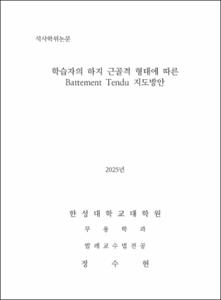학습자의 하지 근골격 형태에 따른 Battement Tendu 지도방안
= Instructional Strategies for Battement Tendu Based on the Lower Limb Musculoskeletal Structure of Learners
- Abstract
- This study aims to analyze ballet educators' tendu teaching methods to identify the critical obstacles experienced by learners during tendu execution influenced by their lower extremity musculoskeletal structure and to provide individualized teaching directions based on these findings. Through this, this study aims to revisit the importance of tendu as a technical foundation for ballet movements and suggest effective teaching methods for establishing basic movements. For this purpose, the results of in-depth interviews with seven female educators and three male educators with twenty-six years of average ballet experience and seventeen years or more of teaching experience are as follows.
First, ballet educators adopted various teaching methods suitable for the learner's physical conditions and performance abilities while adhering to the basic principles of motion when teaching tendu. In particular, they emphasized key elements such as maintaining pelvic alignment, ensuring stability in the standing leg, coordinating external rotation with body alignment, strengthening and segmenting the feet, and utilizing extensor contractions to strengthen learners' ability to perform the movement by teaching in systematic steps based on learners' physical readiness, footwork and orientation, and rhythm and emphasis.
Second, we identified the main challenges of learners' lower limb musculoskeletal structure in performing tendu and found that the challenges included lack of foot strength, muscle activation, excessive use of superficial muscles, and instability of alignment. To improve these challenges, we discussed teaching methods such as strengthening intrinsic muscles, acquiring correct performance methods, activating deep muscles, and maintaining and internalizing correct alignment. Through this study, we proposed practical teaching methods to enhance learners' tendu skills effectively and laid the foundation for improving the quality of ballet education.
Third, we analyzed the tendu instruction according to the learners' lower extremity musculoskeletal structure (FNA, Anterior and Posterior Tilt of the Pelvis, Varus and Valgus, Hyperextended Knee, and Pronation and Supination) and suggested the following instructional strategies: strengthening the core and gluteal muscles, gradually increasing the range of external rotation, using adductors, pull-up, calf abduction, strengthening muscles around the knee, pulling the knee up, strengthening the adductor muscles, and forming the foot arch. The results showed that ballet educators effectively addressed problems in tendu performance by applying individualized instruction based on learners' physical characteristics.
This study will provide a crucial foundation for understanding learners' physical characteristics and applying appropriate teaching methods in educational settings similar to the present study. It will also enhance the quality of ballet performance and support learners' technical development.
This study contributes to improving the efficiency of skill acquisition through individualized teaching methods based on learners' lower limb musculoskeletal structure. It offers valuable educational guidance for consideration in the field.| 본 연구는 발레교육자의 탄듀 지도방법을 분석하고 탄듀 수행 과정에서 학습자가 하지 근골격 형태에 따라 직면하는 주요 난제를 규명함으로써, 이를 기반으로 한 개별화된 지도방향을 제시하는 데 목적이 있다. 이를 통해 탄듀가 발레 동작의 기술적 기반으로서 가지는 중요성을 재조명하고 기초동작 확립을 위한 효과적인 지도방안을 제시하고자 한다. 이를 위해 평균 발레 경력 26년, 지도 경력 17년 이상인 여성 교육자 7명, 남성 교육자 3명을 대상으로 심층 면담을 진행한 결과는 다음과 같다.
첫째, 발레교육자들은 탄듀를 지도할 때 동작의 기본 원리에 충실하면서도, 학습자의 신체 조건과 수행 능력에 적합한 다양한 지도방식을 채택하였다. 특히 골반 정렬 유지, 서 있는 다리의 안정성 확보, 외회전과 신체 정렬의 조화, 발 근력 강화와 분절적 사용, 근육의 신장성 수축 활용 등 핵심 요소를 강조하며, 학습자의 신체적 준비 상태, 발자세 및 방향, 리듬과 강세에 따라 체계적인 단계를 거쳐 지도하여 학습자의 동작 수행 능력을 강화하였다.
둘째, 탄듀 수행 시 학습자의 하지 근골격 형태에 따른 주요 난제를 파악한 결과, 발 근력 부족, 근육의 활성화 부족, 표재근육의 과도한 사용, 정렬의 불안정 등과 같은 난제들이 나타났으며, 이를 개선하기 위해 내재근 강화, 올바른 수행방법의 습득, 심부근육의 활성화, 올바른 정렬 유지 및 내재화 등의 지도방안을 논의하였다. 이를 통해 학습자의 탄듀 수행 능력을 효과적으로 향상할 수 있는 실질적인 교육 방안을 제안하였으며, 발레교육의 질적 향상을 위한 토대를 마련하였다.
셋째, 학습자의 하지 근골격 형태(FNA, 골반의 전방경사와 후방경사, 내반슬과 외반슬, 과신전 무릎, 내번과 외번)에 따른 탄듀 지도방향을 분석한 결과, 코어와 둔근 강화, 외회전 범위의 점진적 확대, 내전근 사용, 풀업, 종아리 외회전, 무릎 주변 근육 강화, 무릎을 위로 끌어 올리듯 펴기, 내재근 강화, 족궁 형성 등의 지도방안을 제시하였다. 이를 통해 발레교육자들이 학습자의 신체적 특성에 맞춘 개별화된 지도방안을 적용하여 탄듀 수행 과정에서 발생하는 문제를 효과적으로 해결하고 있음을 규명하였다. 이는 본 연구와 유사한 교육현장에서 학습자의 신체적 특성을 이해하고 적합한 지도방안을 적용하는 데 중요한 기초 자료를 제공하며, 발레 동작 수행의 질적 향상과 학습자의 기술적 성장을 도모하는 데 기여할 것이다.
본 연구는 학습자의 하지 근골격 형태에 따른 개별화된 지도방안을 통해 기술 습득의 효율성을 제고하는 데 기여하며, 이를 바탕으로 현장에서 고려해야 할 교육의 방향을 제공하는 데 의의가 있다.
- Issued Date
- 2025
- Awarded Date
- 2025-02
- Type
- Thesis
- Files in This Item:
-
-
Download
 200000851815.pdf
기타 데이터 / 866.31 kB / Adobe PDF
200000851815.pdf
기타 데이터 / 866.31 kB / Adobe PDF
-
Items in Repository are protected by copyright, with all rights reserved, unless otherwise indicated.